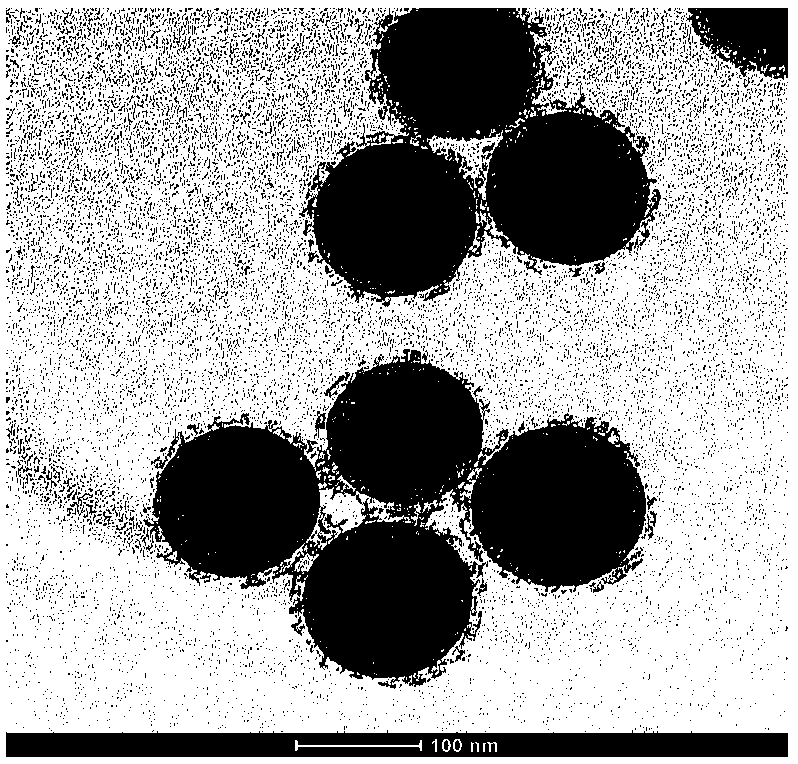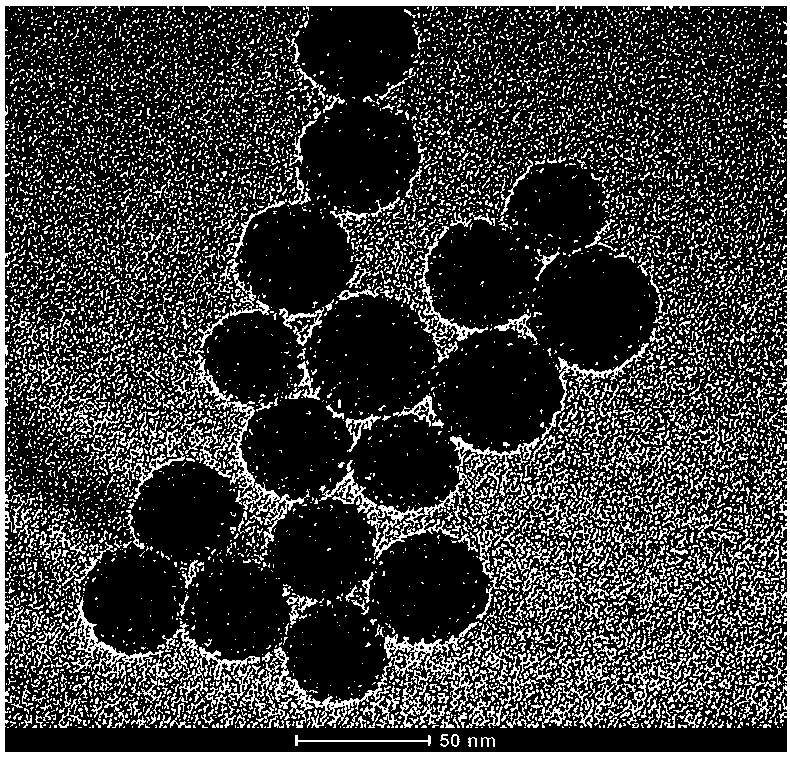A kind of composite catalyst for treating antibiotic waste water and its preparation method and application
A composite catalyst, antibiotic wastewater technology, applied in physical/chemical process catalysts, chemical instruments and methods, metal/metal oxide/metal hydroxide catalysts, etc., can solve problems such as biochemical pool damage, reduce COD value, Wide application range and load-reducing effect
- Summary
- Abstract
- Description
- Claims
- Application Information
AI Technical Summary
Problems solved by technology
Method used
Image
Examples
Embodiment 1
[0026] (1) Preparation of colloidal carbon spheres
[0027] Weigh 10g of sucrose and dissolve it in 80mL of distilled water, then add 0.1mL of 0.1moL / L dilute hydrochloric acid solution, place the solution in an autoclave after ultrasonication, react at a constant temperature at 180°C for 4h, centrifuge the obtained product, and use After rinsing with deionized water and ethanol, place it in a vacuum oven at 80°C for 8 hours to obtain colloidal carbon spheres, such as figure 1 .
[0028] (2) Preparation of C@2%NiO / TiO 2
[0029] Take by weighing 10g colloidal carbon spheres and join in the mixed solution of 41g tetrabutyl titanate and 82g isopropanol, disperse evenly; 0.471g Ni(NO 3 ) 2 After being dissolved in water, it was added dropwise into the obtained mixed solution with a dropper, and the obtained colloid was subjected to ultrasound, standing, and vacuum drying, and then placed in a muffle furnace at 300°C for calcination for 3 hours to obtain C@2%NiO / TiO 2 ,Such...
Embodiment 2
[0035] (1) Preparation of colloidal carbon spheres
[0036] Weigh 10g of sucrose and dissolve it in 85mL of distilled water, then add 0.20mL of 0.1moL / L dilute hydrochloric acid solution, place the solution in an autoclave after ultrasonication, react at a constant temperature at 200°C for 6h, centrifuge the obtained product, and use After rinsing with deionized water and ethanol, they were placed in a vacuum oven at 90°C for 10 h to obtain colloidal carbon spheres.
[0037] (2) Preparation of C@1.5% Fe 2 o 3 / TiO 2
[0038] Take by weighing 10g colloidal carbon spheres and join in the mixed solution of 45g tetrabutyl titanate and 135g isopropanol, disperse evenly; 0.569g Fe(NO 3 ) 3 After being dissolved in water, it was added dropwise into the obtained mixed solution with a dropper, and the obtained colloid was subjected to ultrasonication, standing still, and vacuum-dried, and then placed in a muffle furnace at 350°C for calcination for 4.5 hours to obtain C@1.5%Fe 2 ...
Embodiment 3
[0043] (1) Preparation of colloidal carbon spheres
[0044] Weigh 10g of sucrose and dissolve it in 100mL of distilled water, then add 0.30mL of 0.15moL / L dilute hydrochloric acid solution, place the solution in an autoclave after ultrasonication, and react at a constant temperature of 240°C for 8h, centrifuge the obtained product, and use After rinsing with deionized water and ethanol, place them in a vacuum oven at 140°C for 12 hours to dry to obtain colloidal carbon spheres.
[0045] (2) Preparation of C@2.5%ZnO / TiO 2 spherical structure
[0046] Take by weighing 10g colloidal carbon spheres and join in the mixed solution of 50g tetrabutyl titanate and 250g isopropanol, disperse evenly; 0.583g Zn(NO 3 ) 2 After being dissolved in water, it was added dropwise to the obtained mixed solution with a dropper, and the obtained colloid was subjected to ultrasonication, standing still, and vacuum-dried, and then placed in a muffle furnace at 400°C for calcination for 6 hours to ...
PUM
| Property | Measurement | Unit |
|---|---|---|
| diameter | aaaaa | aaaaa |
| clearance rate | aaaaa | aaaaa |
| clearance rate | aaaaa | aaaaa |
Abstract
Description
Claims
Application Information
 Login to View More
Login to View More - R&D
- Intellectual Property
- Life Sciences
- Materials
- Tech Scout
- Unparalleled Data Quality
- Higher Quality Content
- 60% Fewer Hallucinations
Browse by: Latest US Patents, China's latest patents, Technical Efficacy Thesaurus, Application Domain, Technology Topic, Popular Technical Reports.
© 2025 PatSnap. All rights reserved.Legal|Privacy policy|Modern Slavery Act Transparency Statement|Sitemap|About US| Contact US: help@patsnap.com



